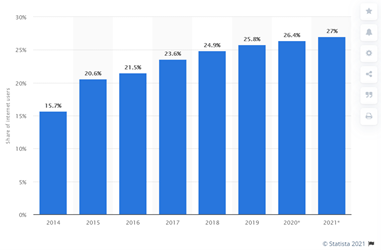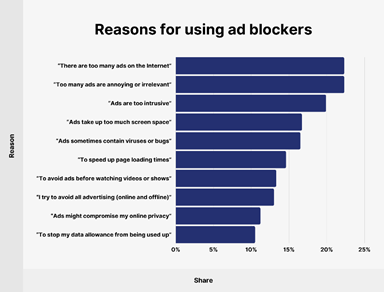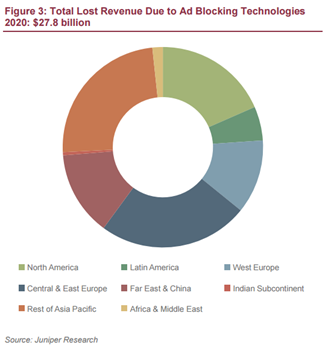
With Apple’s latest iOS update blocking cookies by default, consumers are more empowered than ever to control access to their personal information. As if that wasn’t enough of a challenge for publishers, agencies and advertisers, ad blockers continue to gain momentum, particularly with mobile users. This article provides a comprehensive overview of ad blockers and how publishers and marketers are adapting marketing to address increasing challenges with ad targeting.

According to the 2021 PageFair Adblock Report, an estimated 40 percent of US adults block online ads on computers and phones. While the number of people using ad blockers has held steady at ~250 million for the past few years, adoption has doubled on mobile devices the past five years to nearly 600 million. The primary reasons for ad blockers, according to the survey, is to avoid interruption and annoyance. Other common motivations include protection against malware (62 percent) followed by privacy (58 percent). According to Statista, 27 percent of Internet users currently use some form of ad blocker.

Publisher Strategies to Address Ad Blockers
Publishers are increasingly threatened by the potential loss of revenue; while advertisers are concerned about reduced visibility and wasted spend. The problem has gotten so big that German publisher Axel Springer sued the creator of AdBlock Plus for lost revenues in 2016, a case that is still in court today. The courts have favored ad blocker Eyeo this far, but Axel Springer isn’t giving up easily. This trend may lead to a larger contingent of publishers, advertisers and brands forming a lobbyist group to eradicate the technology.
Some publishers are not outwardly worried about the impact of ad blockers and are conducting business as usual. Other publishers are uncertain of the future and are doubling-down on short-term revenue maximization by adding new inventory including auto-play videos, welcome ads, takeovers, pop-ups and page wraps. A few hold-outs are trying to take a stand against ad blockers and are finding that approach challenging. Below is a recap of the primary strategies’ publishers have taken to address ad blocker proliferation over the past decade.
Staying the course
While this is the most common approach currently, it is not a sustainable strategy. Some publishers are not outwardly worried about the impact of ad blockers and are conducting business as usual. A subset of those publishers is uncertain of the future and doubling-down on short-term revenue maximization by adding new inventory including auto-play videos, welcome ads, takeovers, pop-ups and page wraps. This is equivalent to fueling the ad blocking adoption fire. Long-term, publishers taking this approach will have to change course or risk going out-of-business.
Embracing adoption
A small minority currently, some publishers (typically with minimal advertising) see opportunity in the adoption of ad-blocking software. These publishers can offer unique native advertising or advertorial that is becoming a growing segment and appealing to brands stymied by ad blocking on larger ad-driven websites. Vendors have also sprung up to take advantage of the evolving ad blocker industry. PageFair measures how many people block ads on publisher sites and allows publishers to display discreet ads to ad block software users through the platform. Secret Media uses a “polymorphic encryption algorithm” to accomplish the same task. Companies like Sourcepoint provide a content compensation platform to address ad recovery for advertisers and publishers.
Buying into ad blockers
While taking a good deal of heat, big players like Microsoft and Google are taking a strategic approach by paying to get ads whitelisted by default within the Ad Block Plus software. Irony is abundant: advertising platforms are paying to avoid getting their ads blocked by third parties and the default blocking of ads also creates a moral dilemma. By definition, default ad blocking would violate the principle of network neutrality, which holds that internet providers should treat all types of traffic equally. The conversations are just getting started on this front and look for large publishers and advertisers to fuel the flames.
Developing reward or loyalty programs
When all else fails, some publishers are putting money where their mouths are. Conde Nast, Time and New York Magazine are now rewarding visitors to view ads by providing incentives like points redeemable at select retailers or game credits. The strategy is designed to drive more traffic, ad views and inventory. This is neither a new tactic (first used in the mid- to late-nineties) nor is it proven to be highly effective, as participants are typically only visiting to earn rewards rather than for the content or the ads. Regardless, look for more publishers to test this approach in the near future.
Improving the user experience
Since a majority of workarounds are not viable long-term, smart publishers are looking at alternatives. Undeniably, publishers will benefit from creating the best possible user experience by building in advertising options that are seamless and/or add value. Focusing on site speed, minimized but expandable ad formats and native advertising can create a win-win for all parties (publishers, advertisers and consumers). In the end, compelling content will drive readership and creative ad formats. Sponsorships or endorsements may be the best compromise to keep publishers in business, advertisers connected and consumers happy. This is the solution that will ultimately provide the greatest return for publishers.
Educating readers
An increasing number of publishers are taking a more direct, transparent and collaborative approach. These sites have chosen to educate ad blocker users regarding the impact of the lost revenue to the publishers and request they whitelist the website to enable the ads. Wired, Mixcloud and others have seen success with this approach. I predict this will become the de-facto starting point for a majority of publishers in 2016, as it has a relatively low cost and takes the high road. That being said, the efficacy of this approach is dubious at best, based on historical data (that readers prefer ad-free and cost-free news and information).
Going rogue
Some publishers are utilizing technology workarounds to subvert ad blockers, including tweaking URLs and using URL shorteners. This is of course a cat and mouse game that will be difficult for publishers or ad blockers to win. The Washington Post has taken to blocking the blockers, detecting when visitors are using an ad blocker and asking them to turn it off before they can view content. Due to the never-ending escalation of costs associated with this approach, I predict this will be one of the least popular strategies to combat ad blocking. Some companies are taking advantage of the conflict and are developing alternative solutions for consumers and publishers. Optimal.com is a “smart subscription service for all the content on the web, minus the ads. Time will tell if these options are appealing to readers, as they are not likely favorable to publishers or advertisers in their current format.
Lobbying and pursuing legal action
While publishers are increasingly threatened by the potential loss of revenue, advertisers are concerned about reduced visibility and wasted spend. The problem has gotten so big that German publishers sued, Eyeo, the creator of AdBlock Plus earlier this year for lost revenues. French publishers are considering doing the same. The courts have favored Eyeo this far, however. This trend may lead to a larger contingent of publishers, advertisers and brands forming a lobbyist group to eradicate the technology. The challenge with the legal approach is extremely high costs with long odds. The strong-arm approach also does little to engender trust or respect from readership.
Building a paywall
Another approach to thwarting ad-blocking is to create a paywall (a system that prevents Internet users from accessing web page content without a paid subscription) so that paying users are able to skip advertising all together. Paywalls are the flip-side of ad-blocking software, in that you pay the publisher for the ability to avoid ads, instead of ad blocking software. For example, The Guardian is inviting users who choose to block ads to support the paper by becoming paid-up members. YouTube and The Next Web are planning to take a similar approach. Alternately, a “premium content” strategy can be positioned as more consumer-friendly. Instead of penalizing visitors using ad-blockers by creating a paywall, publishers can reward visitors by offering them additional benefits or access when disabling ad-blockers.
Playing hardball
A fringe group of publishers are taking a hardline approach to prevent ad blocker users from accessing content. Video streaming and media sites like Hulu and UK’s ITV and Channel 4 have taken this angle. Forbes has developed a hybrid approach by both hiding content from ad blocker users and promising an “ad light” experience (no autoplay videos or animation) to those that turn off their ad blockers. GQ is a firm but practical approach. Site visitors interested in reading articles instead receive a popup asking to turn off their ad blocker or pay .25 cents.
The smartest approach, in my humble opinion, is to improve the user experience with smarter and more user-friendly layouts, ad formats (i.e. native advertising, video and cinemagraphs) and generally reducing the number of ad options. The idea is that attention will be divided among fewer ads and improve performance. The publisher can also charge more for each ad and the brands and agencies can spend more time developing compelling creative. Advertisers may migrate to other (social) platforms and solutions, including Facebook and Twitter feeds.
Brand Advertiser Strategies to Address Ad Blockers
The best way for brands and creatives to effectively mitigate the impact of ad blockers, is to understand the motivations behind usage. Once brand advertisers (and publishers) address consumer concerns about digital ads, lost revenues can be mitigated. According to Juniper Research, total revenue lost due to ad blocking technologies reached nearly $28 billion in 2020.

With so much to lose, brands must get serious about addressing consumer concerns. Let’s take a deeper look at key motivators for using ad blockers and associated mitigation strategies.
- The ads are annoying. Bad creative can be downright irritating. Recommended fix: invest more time on development of compelling creative that resonates with the target audience. Spend more time and effort on market research, strategic planning and testing, to hone the creative.
- The ads get in the way of what I’m trying to do. While intrusive ads (think pop-ups and expandable ads) can generate a higher number of clicks, it is not usually because people find the creative or product compelling. Similar to mobile devices, people tend to click accidentally on intrusive ads. This only infuriates the user and can result in a negative brand perception. Recommended fix: buy ad placements that are less-intrusive or completely non-intrusive. Examples might include sponsorships vs. display ads. According to recent research, one in three users was positive toward an ad-light experience with fewer advertisements shown in exchange for turning off their ad blockers.
- The ad is irrelevant to me. As web surfers, we tend to ignore irrelevant ads, but that doesn’t mean they don’t have a negative impact and inspire blocker usage. Recommended fix: invest more time in audience segmentation and targeting. Understand your audience motivators and preferred media outlets and have the discipline to actively manage digital campaigns for optimal ROI. Run-of-site or run-of-network ad buys are a lazy approach and key driver of ad blocking.
- I find the ads too intrusive. If you’ve surfed the web for work or play in the past year, you’ve probably experienced intrusive ads, including pre-roll on YouTube or interstitials on large publishers. Overlay ads are popular because they demand the user’s attention and advertisers can guarantee impressions. Unfortunately, users find these ads frustrating. Recommended fix: See #3. Stay away from intrusive ad buys. Look for alternatives, per #2.
- The pages tend to load faster when adverts are blocked. Any web developer will agree that fewer ads = faster download speeds = better user experience. In fact, Google has indicated site speed impacts rankings in search results. Unfortunately, this insight conflicts with a publisher’s need to generate revenue. Recommended fix: consider ad buys on websites with limited inventory, elegant user experience or perceived faster download times. Also consider creating ads that are small in file size that minimize impact on the user experience.
- It leads to a saving of my mobile data. This is perhaps the most difficult to combat but is thankfully the least important of the top motivators. Recommended fix: not much you can do here, unless you plan to buy those viewing your ads additional data on their mobile plans. Perhaps suggest they view the website on wi-fi or at work. Yeah, right.
Parting Thoughts
Advertisers and creatives are in a tough spot due to growth of ad blocking (and a cookieless future). I’ve mentioned a few mitigation strategies above, based on the top six motivators. Here are a few additional thoughts from other industry influencers.
During a panel at Cannes Lions International Festival of Creativity, Randall Rothenberg, president-CEO of the IAB suggested that brands should “serve people and not impressions through better creative.” The panelists also suggested less intrusive ad formats with better targeting. In another panel at the same event, PepsiCo’s president Brad Jakeman said “Ad-blocking is the best thing that has happened to this industry” arguing it will drive the industry to act more like entertainment brands.
My fellow teammates at Anvil came up with additional workaround strategies for ad-blocker users. The first strategy is to get “white-listed” by following ad blocker best practices in order to advertise through ad blocker networks or related technology platforms like PageFair and Ghostery. The second is my foundational recommendation from previous articles: native advertising. Create your own content that is so compelling that nobody cares that it is technically considered advertising.
Additional workarounds include in-app advertising (which can still be considered intrusive) but users may be more tolerant depending on the application and creative. Increasing engagement levels can also decrease user frustration. Consider unique ad formats that incorporate multimedia. This is a riskier approach, as it can increase download times and be considered even more intrusive than static ads.
Conclusion
At its core, ad blocking software is a powerful response by consumers tired of poorly executed and placed creative. Brands and agencies that heed the call will invest more time on developing data-driven creative, further audience segmentation, improved targeting and thoughtful media placement. Publishers must also do their part to provide more options for advertisers that address many of the consumers’ biggest complaints. Consumers have voiced their concerns and the advertising industry is now starting to listen. The result should be a better experience for all parties involved. At least we hope that is the case.

Kent Lewis founder of pdxMindShare, an online career community and networking group mentioned on Seth Godin’s blog. Formerly a CMO and founder or co-founder of multiple agencies, he’s known as a thought leader in digital marketing. He’s been an adjunct professor for more than 20 years at Portland State University and a volunteer instructor for SCORE. Lewis co-founded SEMpdx in 2006, a trade organization for search engine marketing professionals. His recognition includes Marketer of the Year by the American Marketing Association and Top 100 Digital Marketing Influencers by BuzzSumo.
